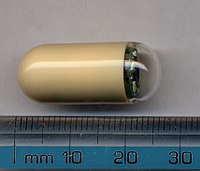
Photo from wikipedia
Growth of biofilm in the channels of endoscopes is common [1]. Damage to the channels, followed by formation of biofilm, may occur during both endoscopic procedures and the cleaning process.… Click to show full abstract
Growth of biofilm in the channels of endoscopes is common [1]. Damage to the channels, followed by formation of biofilm, may occur during both endoscopic procedures and the cleaning process. Biofilm is difficult to remove, and microbial contamination increases with the age of the endoscope [2]. The quality of reprocessing of endoscopes is believed to be associated with the contamination rate [3]. These aspects are not relevant for single-use endoscopes. A 60-year-old woman with osteoporosis was referred for a diagnostic esophagogastroduodenoscopy (EGD) due to iron deficiency anemia. The patient had no gastrointestinal symptoms or symptoms of anemia. A colonoscopy with normal findings had been performed prior to referral. EGDwas performed using a novel sterile single-use endoscope (Ambu aScope Gastro; Ambu, Ballerup, Denmark). The procedure was performed in our endoscopy unit by a junior medical doctor (▶Video 1). The endoscope was unpacked in the endoscopy room (▶Fig. 1, ▶Fig. 2) and connected to the aBox (▶Fig. 3.) The patient was given a local anesthetic throat spray prior to intubation. No sedation was needed. Except for a hiatal hernia, there were no abnormal findings in the duodenum, stomach, or esophagus. Duodenal and gastric antral biopsies were taken. The EGD was performed uneventfully and using the endoscope was feasible in terms of image quality and maneuverability. The complete single-use endoscope setup is more portable than the conventional setup because the aBox replaces existing endoscopic platforms. This enables the endoscopist to perform some procedures without moving the patient to the endoscopy unit or the operating room. Furthermore, there is no need for cleaning and repairs, which saves additional resources [4]. Our case demonstrates a successful diagnostic EGD using the novel single-use disposable gastroscope (▶Fig. 4). Single-use endoscopes should be considered as an alternative when time and availability are essential.
Journal Title: Endoscopy
Year Published: 2022
Link to full text (if available)
Share on Social Media: Sign Up to like & get
recommendations!